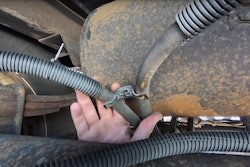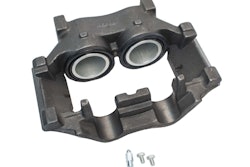The following was published in CCJ's Equipment Maintenance Toolkit, 9th edition, updated July 2023 and sponsored by Valvoline Heavy Duty. CCJ's Equipment Maintenance Toolkit is a complementary industry resource, courtesy of our partnership with Valvoline Heavy Duty. You can download the entire Toolkit here.
From the owner-operators to the maintenance managers and technicians, it is everyone’s responsibility to keep the total cost of ownership (TCO) as low as possible. In the fast-paced world of fleet maintenance, that is often no easy task.
One of the most difficult challenges facing fleet managers and technicians is staying abreast of the different emerging trends. Whether those trends complement each other or are in conflict, fleets must decide which elements to add into their programs and which to ignore so the focus remains on total operational efficiency.
One trend that has been largely overlooked in the trucking industry is the use of lower-viscosity engine oils, specifically the use of API FA-4 certified lubricants, which can help improve fleets’ performance tremendously. Launched in 2016, FA-4 oils are generally approved for use in engines model year 2010 and newer. Detroit, International and Cummins have approved FA-4 for use in their engines.
Not only can fleet-wide use of low-viscosity engine oils enhance fuel economy, but they also help fleets reduce total operational costs. Furthermore, using FA-4 certified lubricants can have positive effects throughout an organization.
The benefits to operations and maintenance
What defines lower-viscosity engine oils more than any other characteristic is their ability to prevent friction between the components of an engine, which allows them to operate more efficiently. Any engine that employs a lower-viscosity oil will use less fuel and reduce the energy needed to produce the same amount of work.Fleet owners who have made the switch report remarkable results. Class 8 over-the-road fleets can realistically expect fuel savings in the range of 0.5%-1.5% by switching from 15W-40 to 5W/10W-30 engine oil. Switching to the fuel-efficient FA-4 variant can be expected to add a further 0.4%-0.7% of increased fuel efficiency.
When projected over an entire fleet, the savings can really add up, and with approximately 22% of a fleet’s average cost per mile made up of fuel costs, it’s an ideal area for cutting cost. Considering the significant rise in on-highway diesel prices this year, that has never been more important.
Fuel savings aren’t the only benefit that low-viscosity lubricants bring to fleet managers. They also improve the overall durability and longevity of the engine because they don’t put as much stress on moving engine components. Over the lifetime of the vehicle, that means the trucks will require less maintenance and will experience less downtime.
In addition, API FA-4 oils are designed to extend drain intervals, which allows trucks to remain on the road longer without needing an oil change. While individually these costs may not seem like much, taken together they make a strong case for maintenance managers to consider moving to low-viscosity lubricants.
How low-viscosity lubricants help organizations strategically
The benefits of lower-viscosity lubricants extend far beyond maintenance bays. As emissions have become a priority for organizations, low-viscosity lubricants can help reduce them and bring fleets into compliance with state and local emissions guidelines.
Each vehicle in a fleet can be on the road for more than a million miles before it is retired, and over that lifetime it produces carbon dioxide emissions – a significant contributor to global climate change. By switching to FA-4 formulations, however, the amount of carbon dioxide emitted from the tailpipe could be reduced by 10 to 12 tons. When the reductions of an entire fleet are combined, it’s easy to see the environmental effects of the fleet are significantly reduced.
In addition to reducing carbon dioxide, organizations of all kinds are trying to lower their Scope 1, 2 and 3 emissions as well. Scope 1 are direct greenhouse gas (GHG) emissions from directly held company assets. Scope 2 emissions are indirect GHG that come from purchasing energy like electricity, steam, heat, or cooling. Scope 3 — where fleet managers could have the most significant effect – are emissions derived from supply chain partners, which often make up the majority of a company’s total GHG emissions.
Scope 3 emissions are driving more companies than ever to seek partners who are committed to reaching high environmental standards that mirror their own. Most companies will do significant research on business partners to determine how well companies are addressing environmental concerns before signing contracts, so it behooves trucking companies to be on the right side of that ledger.
All applications deserve top-tier fluids
Though changing engine oils is a crucial component to improving a fleet’s performance and efficiency, it may make sense to evaluate all the other upgrades that might be available on other fleet-level lubricants. Whether it’s driveline fluids, fuels or greases, each can help improve a fleet’s overall performance and should be evaluated on a regular basis.When used together, a well-chosen combination of high-performance fluid products can significantly affect a company’s bottom line positively if they are used across an entire fleet. They contribute to decreased life cycle expenses, reduced maintenance costs and better fuel economy. Choosing a lubricant supplier that can identify specific needs within fleets and provide the right solutions is paramount. Working together, fleets and their suppliers should be able to advance tailored solutions that will reduce TCO and provide significant boosts to a company’s profitability.
Greg Matheson is a commercial lubricants product manager for The Lubrizol Corporation. Since joining Lubrizol in 2015, Greg has worked as an OEM account manager, managing Lubrizol’s business with the heavy-duty truck and engine builder OEMs in North America. In his current role, Greg is responsible for a wide variety of API CK-4 and FA-4 additive products in North America and globally for Lubrizol. Before coming to work at Lubrizol, Greg spent close to 10 years in the trucking industry working for Travel Centers of America.
Gregory Garwood is a business development manager for The Lubrizol Corporation. Since joining Lubrizol in 2010, Greg has worked as a global product manager for Fuel Additives, commercial manager for Oilfield Chemicals, breakthrough innovation manager for Lubrizol Additives, and commercial manager for Automotive Gear Oils. In his current role, Greg is responsible for accelerating new and adjacent market growth for Lubrizol’s Industrial Additives business. Prior to his tenure at Lubrizol, Greg worked in various commercial roles for specialty chemical and commercial manufacturing businesses.













